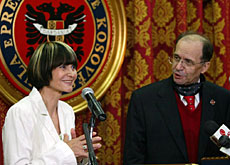Kosovo remains peacekeepers’ testing ground

The role of Swiss peacekeepers in Kosovo has been in a state of flux since the first Swisscoy contingent was deployed in the Serbian province six years ago.
swissinfo found the soldiers carrying out armed patrols as well as concentrating on providing logistical support.
An armoured personnel carrier follows closely behind a four-wheel-drive vehicle. But before heading out on patrol, the Swiss troops have to get past the military camp checkpoint, manned by Austrian soldiers.
The guards meticulously check to ensure the Swiss are wearing bulletproof vests and helmets, and check their guns and travel documents.
The members of the mechanised convoy are part of a 220-strong Swisscoy contingent, assigned to the Austrian-led Task Force Dulje in Suva Reka, located between the capital, Pristina, and Prizren.
The Swiss contingent focuses on providing logistical support; setting up camps, special transports, water processing, medical help and engineering. But since 2002, Swisscoy has had five armoured personnel carriers at its disposal which it uses on patrol outside the camp.
The patrols were made possible after Swiss voters in 2001 approved a change to the constitution allowing Swiss peacekeepers to carry guns on foreign missions.
“It’s part of our job to check the roads in the villages and the mountains,” a soldier tells swissinfo during one such outing.
Schoolchildren wave from the side of the poorly maintained road as the convoy passes. They are not frightened by the sudden appearance of the noisy military vehicles, spewing dirt.
The international peacekeeping force, Kfor, is still welcomed by a large part of Kosovo’s Albanians – who account for a majority of the population.
Roadblocks
The Swiss troops eventually find one of the roads leading out of the village blocked. The soldier radios the details back to headquarters. “It’s vital to keep the roads open in crisis situations,” he says.
The convoy continues on its way before making a sudden halt at a car park. Both vehicles turn and face the road at an angle. A soldier motions for an oncoming car to pull over.
The driver gets out and steps away from the car. The soldiers approach and use a metal detector to ensure he is not carrying a gun. They then proceed to open the bonnet and boot to look for weapons.
It is a routine check and they find everything in order. The man is sent on his way, and the procedure is repeated with the next car and driver. The road check lasts about half an hour.
“We never decide in advance when or where we’ll control vehicles,” explains the highest-ranking officer. “We usually stop young men driving newer car models. Most accept being pulled over,” he says.
The convoy moves on to a school where the soldiers meet local officials to gauge the atmosphere and security situation in the village.
The headmaster invites everyone into his office where he describes the difficulties faced by the school.
The students pose no problems, he says, but the poor condition of the unpaved access road does, as well as the mountains of rubbish waiting for collection and the unpaid salaries of his staff.
Who’s in charge?
The headmaster says it seems nobody is willing to take charge. “The well-paid United Nations officials look after themselves first,” he complains. “We would be better off if we had our independence and then we would be able to get loans.”
The Swiss contingent receives an order to proceed into the mountains where they are to guard a Serbian monastery, instead of performing their usual policing duties.
The Kfor command expects that a pro-independence demonstration planned by Albanians could end in rioting, and has placed all troops on red alert.
Since violent unrest in the spring of last year caught the international peacekeeping force off guard, efforts have been made to increase soldiers’ readiness to deal with demonstrations.
Swisscoy troops are now outfitted with riot gear including shields and truncheons, and take part in weekly exercises to learn how to handle demonstrations, and to prevent ethnic clashes.
But the feared clashes do not materialise and the Swiss return to the Suva Reka camp the next day. Normality – Kosovo-style – returns.
swissinfo, Andreas Keiser in Suva Reka
The 220-member Swisscoy contingent is part of the 20,000-strong Nato-led Kosovo Force (Kfor), responsible for maintaining peace in the Serbian province.
Swiss peacekeepers have been active in Kosovo since Kfor took responsibility for security in the region in 1999.
The Swiss are assigned to the Austrian-led division in Suva Reka.
The Swiss government has extended Swisscoy’s mandate until the end of 2008.

In compliance with the JTI standards
More: SWI swissinfo.ch certified by the Journalism Trust Initiative










You can find an overview of ongoing debates with our journalists here . Please join us!
If you want to start a conversation about a topic raised in this article or want to report factual errors, email us at english@swissinfo.ch.